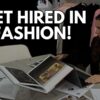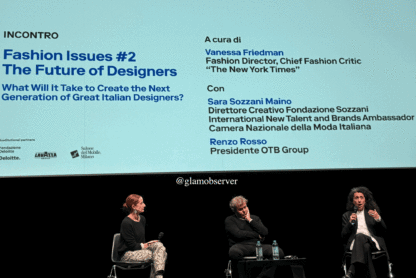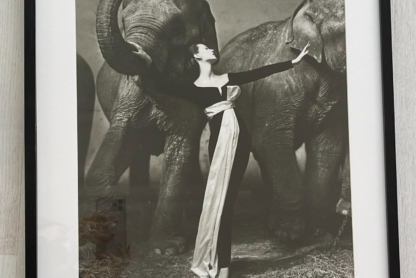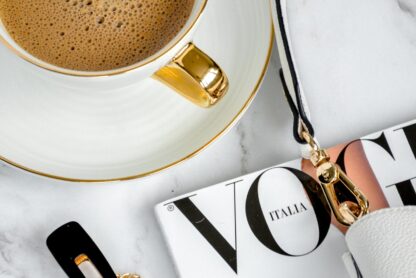Anna Wintour. The Lady behind the dark sunglasses. The name everyone in the fashion industry and beyond knows very well and hears in different contexts. One day we recognize her in Meryl Streep’s character Miranda Priestly in Devil Wears Prada (whether this association is true or wrong- we will never know). In May of each year, her name comes again on the occasion of the Met Gala. Anna Wintour is unmissable when attending fashion shows and is always spotted in the front row. And of course, whoever reads or has heard of American Vogue knows the leader behind it – Anna Wintour.
Anna Wintour is an example for many people working in fashion and those who dream of breaking into the industry. But how well do you actually know her? Her great work at Vogue and her influence in the fashion industry are undeniable. But it’s important to understand that this power did not come from nothing. Therefore, it’s interesting to look at how she started and evolved throughout her career to be where she is, and how she became the person she is today. I read Amy Odell’s book Anna: the biography (which by the way we read in our fashion book club on 365 days of fashion – our daily newsletter that teaches you the fashion industry fundamentals) and it helped me understand Anna and her life and career better.
In this article, I am breaking down the mystery of why Anna Wintour is so famous, and what she did at the early stages of her career that made her such a powerful and influential figure in the fashion industry and beyond.
Why Is Anna Wintour Famous
Who Is Anna Wintour
Anna Wintour was born on November 3d, 1949 in London to Charles Wintour, who was the editor of The Evening Standard, and Eleanor “Nonie” Trego Baker who worked as a freelancer reviewing television shows and reading scripts for Columbia Pictures, and she also was a film critic. When she returned to work full-time, she became a social worker helping pregnant teens to find adoptive parents for their children. Anna Wintour was close to her parents. She adopted the political convictions and strong will of her mother, and the professional ambition of her father.
Anna Wintour had a brother Gerald who died in a traffic accident as a child. And now she has 3 brothers and sisters – Patrick, who is a diplomatic editor at The Guardian, James who serves in London’s local government, and Nora who is a former international trade union official. And is now an independent researcher, writer, and policy advisor on industrial relations, labor rights, and equality and non-discrimination.
How Did Anna Wintour Become A Journalist
Of course, it all started with a vivid interest in fashion. Anna attended the prestigious private girls’ school Queen’s College in 1960. But she didn’t like going to school, though she excelled in English. She frequently rebelled against the dress code by taking up the hemlines of her skirts. (This was a time when the mini skirt became a trend, popularized by Mary Quant and André Courrèges.) She transferred to North London Collegiate School in 1963 but left it at 16 years old without completing her final year.
Already when she was a teenager, Anna paid important attention to style and mocked people at her school who did not have it. She wanted to be dressed as the best person in the room. She liked to dress on weekends as she pleased. Liked shopping (sometimes to skip classes), and enjoyed watching Ready, Steady, Go! – a British rock and pop television program.
Just like many girls, Anna Wintour’s interest in fashion increased while reading fashion magazines. And her favorite of all was Seventeen, which her grandmother sent her from the US. The fact that she grew up in London at a time when fashion was at the heart of cultural transformation, also played its part. Anna kept up with everything new and trendy and was a voracious reader. She consumed books, magazines, and newspapers.
“I think my father really decided for me that I should work in fashion,” Anna said in The September Issue.
He found her a job at the Biba shop when she was 15. She also did some tasks for Pitticoat magazine which was founded by her stepmother Audrey Slaughter, and took some fashion classes. But she abandoned them, saying a sentence that later became a famous quote: “You either know fashion or you don’t”.
Anna Wintour is so iconic in her role as Vogue’s editor-in-chief that it’s hard to imagine she was doing something else before. But just like anyone, she started her career from the bottom moving her way up and held positions at other magazines.
Anna gained her first experience at a magazine working at Oz, which was given to her by her then-boyfriend, Richard Neville. The publication was attacked for its “controversial” topics at the time, though.
Then in 1970, Anna started her five-year career as a fashion assistant and later deputy fashion editor at Harper’s & Queen (a merge of Harper’s Bazaar and Queen), which was founded by Willie Landels.
“I learned how to go into the market and choose clothes. I learned how to choose talent. I learned how to collaborate. I learned how to do a layout. I learned how to write a caption. I was thrown into my career, frankly, with ignorance. I knew nothing. You had to learn everything, you had to do everything, you had to know how to multitask. I think this also gives you a certain strength that you are not stuck in one box. I just started as an editor, they told me to go on a shoot,” Anna once shared, as I know from Amy Odell’s Anna: the biography.
She had an assistant working for her – Clare Hastings – who recalled in an interview:
“Anna had the power to make people do what she wanted with a look or a sentence”. She held a busy social life, attended fashion shows, and was always looking for the best people to work with. After multiple disagreements with her rival, Min Hogg, who got the fashion editor job she wanted, she quit Harper’s & Queen and moved to New York with her boyfriend, freelance journalist Jon Bradshaw.
In New York, Anna worked briefly as a freelancer for American Vogue. Later, she became a junior fashion editor at Harper’s Bazaar US in 1975. But her innovative, “too sexual” shoots led editor Tony Mazzola to fire her after nine months.
A few months later, Jon Bradshaw helped Anna get her first position as a fashion editor at Viva, a women’s adult magazine founded by Kathy Keeton, then wife of Penthouse publisher Bob Guccione. Anna was in charge of connecting with brands and bringing advertisers. She had a lot of creative freedom there and strived to build a feminist magazine. But it didn’t overcome the stigma as an erotic publication, so on November 18th, 1978, Viva ceased its operations.
After Viva, Anna Wintour and her boyfriend traveled the world, which is said was her only true break from work.
She returned to New York in the Spring of 1980 and started working as a fashion editor at Savvy – “the magazine for executive women”. But Anna couldn’t relate to the female readership, who were lawyers and bank workers. And were looking for office clothing at low prices – not expensive runway clothes. They would occasionally send her letters saying they wouldn’t wear this and that and couldn’t afford it. So eventually she quit. However, even if her taste in fashion didn’t match with the tone of Savvy, Anna did like the idea of businesswomen reading the magazine. And she later targeted this audience at Vogue.
In 1981, Anna became the fashion editor of New York magazine. She put celebrities on the covers, which resulted profitably. “Anna saw the celebrity thing coming before everyone else did”, Grace Coddington said three decades later.
After spending several years at British Vogue, (which we are going to talk about further,) Anna Wintour took over House & Garden in 1987. Again, she made radical changes to staff and the look of the magazine. She put so much fashion in photo spreads that it became known as “House & Garment”. When the title was shortened to just “HG”, the publication was no longer working, as many longtime subscribers thought they were getting a new magazine and didn’t read it, and many advertisers pulled out.
As you can see, Anna Wintour had quite an extensive career that prepared her for her dream job – Vogue.
When Did Anna Wintour Start At Vogue
In 1983, Anna Wintour was chosen by Alex Liberman, then editorial director of Condé Nast, to be the creative director of American Vogue. Her changes to the magazine were often made without then editor-in-chief Grace Mirabella’s knowledge, which caused friction between them. Also because Anna openly said to her during an interview that she wanted Mirabella’s job.
Then in 1985, Anna became editor-in-chief of British Vogue. This is what Amy Odell shared with Glam Observer in an interview about Anna Wintour’s role:
“So she gets this job at British Vogue and she probably felt like she has to turn the magazine around fast. It’s in her nature to get things done efficiently. So what did she do? She cleaned out the staff, got rid of a lot of people and completely changed the magazine. She changed the look and the fashion totally, before her it was kind of a romantic feel. It went from photos of women with horses and twigs in their hair to women in suits chasing taxis.
She totally changed the front of the book, cut columnists, and brought in new people. And she did that all very fast. It was just really unlike the culture of British magazines at the time. The EIC didn’t just come in from New York and totally change the staff and everything about a magazine and that’s what she did. This really kind of led to her reputation.”
Wintour’s ideal reader was the same woman Savvy had tried to reach.
“There’s a new kind of woman out there”, she told the Evening Standard. “She’s interested in business and money. She doesn’t have time to shop anymore. She wants to know what and why and where and how.”
Although Anna Wintour’s dream of working at Vogue became true (or better said – she paved her way to it,) what she wanted the most was to return to American Vogue. And she did – in 1988. She changed everything in the magazine – from the staff to Vogue’s vision, to how its front covers looked like. Her first November 1988 issue featured on the cover a 19-year-old model Michaela Bercu in a $50 pair of faded jeans and a bejeweled jacket by Christian Lacroix worth $10,000. It was revolutionary because it was the first time a Vogue cover model had worn jeans.
Fun fact: when the print company saw it they thought it was the wrong image and called the magazine to check if it was correct. And their surprise is understandable. As Vogue used to feature headshots of well-known models in studios under Grace Mirabella. And on the opposite, Anna Wintour used less well-known models. She also mixed inexpensive clothes with high fashion. And that’s how began Anna Wintour’s exciting career at Vogue.
Besides being editor-in-chief for 35 years, Anna Wintour serves as Artistic Director at Condé Nast since 2013. She is also the President of the Met Gala since 1995. The CFDA/Vogue Fashion Fund was created under the leadership of Anna Wintour. Also, the Costume Center at the Metropolitan Museum of Art is named after her.
Anna Wintour’s Influence on Fashion Industry
There are many reasons why Anna Wintour is an influential figure in the fashion industry. The first one is that she has been editor-in-chief at Vogue since 1988. And this is the leading fashion magazine in the U.S. and the world, so that means something.
Her influence even expands beyond the fashion industry. For instance, Serena Williams considers Anna to be a close confidant and described calling her when she was struggling with tennis before going on to win Wimbledon based on the advice that Anna gave her. Another example is when Bradley Cooper sent over his script for A Star Is Born before he had cast Lady Gaga in the role, to get Anna’s input on it. Amy Odell shared with us:
“I think that a lot of people really trust her taste and she is a very savvy business women. And I think her strength is really that she’s able to communicate very effectively with Vogue creative and business people. There are a lot of people in fashion who are fantastically creative and brilliant but they don’t have that ability that she has to talk to business people and deliver advice that they want to take. I talk in the book extensively about all those fashion editor jobs that she had before she got to American Vogue. She held so many other positions, she worked her way up, so she understands that and how that world works. So she’s really able to handle both sides of the business.“
Throughout her extensive career in fashion, Anna Wintour built a big network, composed not only of fashion professionals but also of politicians, sportsmen, etc.
As an editor-in-chief, you have to be curious about the different topics – art, culture, politics – everything is valuable and adds to your general culture. And it involves meeting people outside of your circle and industry. And the fact that Anna managed to grow her network allows her to find the best people to contribute to Vogue. And also build her own reputation and influence within the fashion industry.
Anna Wintour is regarded by many as the most influential person in the fashion industry because she is – and always was since the beginning of her career – so passionate about fashion. Since she was a teenager, not only did she read a lot to inform herself about fashion, but she was also looking for work opportunities. And from what I have read about her experiences at the different magazines, it seems like she worked a lot with dedication and passion.
Another reason for Anna’s success and fame must be due to the fact she always liked to do things her own way since she was just an assistant. As we saw, this resulted in clashes many times with her superiors and colleagues. And she was often referred to as “nuclear Wintour”, but she wasn’t afraid to be herself and share her ideas. Having a personality and strong opinions allows you to create unique content and get people to respect you and eventually they follow along. I think this is what happened with Anna.
Plus, she showed incredible persistence throughout her career, which as we saw had ups and downs.
Being fired or quitting several magazines could have made her change her mind about pursuing a career in fashion and working her way up to American Vogue. But instead, Anna was resilient and didn’t give up on her dream. Nor she betrayed her approach to work, her sense of aesthetics and taste in fashion.
Anna is often spoken of as someone who has a strong work ethic, and excellent time management skills. Her morning routine looks like this: she wakes up between 4 and 5 a.m, reads newspapers, sends some emails to her staff, plays tennis, and then heads to the office. Not only this plays in her favor, but it also shows people around Anna that she is organized. This skill is one of the secret ingredients to success and a good reputation.
It seems to me like there is a lot of mystery about why Anna Wintour is so successful. But I think the answer is simple: she worked for it. From her first days as a fashion assistant, or even when she was working at Biba at 15 years old, it seems like she took all of her jobs very seriously. And at the same time, she had her own vision and how she liked to do things. And wasn’t afraid to suggest her ideas. She was also curious about many things. She went out there and spoke to people.
This doesn’t mean we are all going to become the next Anna Wintour at Vogue. But maybe we could be our versions of Anna Wintour elsewhere – in our own dream job. Having passion and a strong work ethic is totally achievable. And this combination definitely eventually leads to success somewhere – working at a fashion magazine or at a brand, or building your own company.
Anna Wintour’s career ethic and habits are everything we advise you on Glam Observer to incorporate into your life to build a successful career in fashion.
Be passionate about fashion and your job. Stay organized. Talk to as many people as possible to grow your network. With passion and hard work, you too can make a contribution to the fashion industry (and elsewhere) and be an inspiration for people.
If you want to learn more about Anna Wintour, we suggest you watch The September Issue, and read the book by Amy Odell Anna: the biography. We also invite you to listen to the Glam Observer’s founder Giada Graziano interview with Amy on Apple Podcasts or Spotify.
Credits: some parts of this article were built on the information received from reading Amy Odell’s book Anna: the biography.
By Margarita Skacenko









This is an amazing article and a great reminder that a career path isn’t always linear.